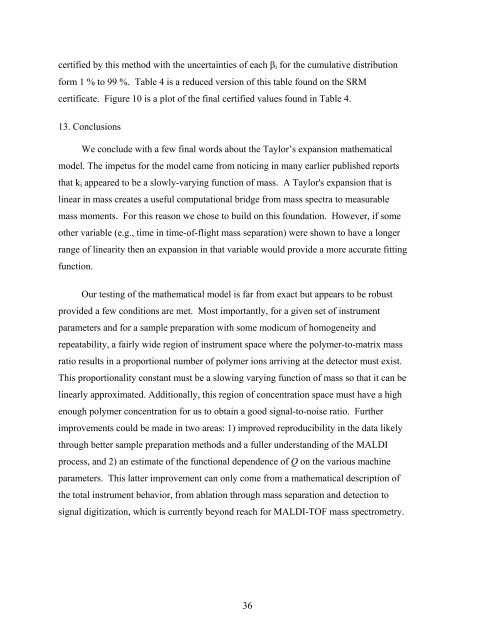Standard Reference Material 2881 - National Institute of Standards ...
Standard Reference Material 2881 - National Institute of Standards ...
Standard Reference Material 2881 - National Institute of Standards ...
You also want an ePaper? Increase the reach of your titles
YUMPU automatically turns print PDFs into web optimized ePapers that Google loves.
certified by this method with the uncertainties <strong>of</strong> each β i for the cumulative distributionform 1 % to 99 %. Table 4 is a reduced version <strong>of</strong> this table found on the SRMcertificate. Figure 10 is a plot <strong>of</strong> the final certified values found in Table 4.13. ConclusionsWe conclude with a few final words about the Taylor’s expansion mathematicalmodel. The impetus for the model came from noticing in many earlier published reportsthat k i appeared to be a slowly-varying function <strong>of</strong> mass. A Taylor's expansion that islinear in mass creates a useful computational bridge from mass spectra to measurablemass moments. For this reason we chose to build on this foundation. However, if someother variable (e.g., time in time-<strong>of</strong>-flight mass separation) were shown to have a longerrange <strong>of</strong> linearity then an expansion in that variable would provide a more accurate fittingfunction.Our testing <strong>of</strong> the mathematical model is far from exact but appears to be robustprovided a few conditions are met. Most importantly, for a given set <strong>of</strong> instrumentparameters and for a sample preparation with some modicum <strong>of</strong> homogeneity andrepeatability, a fairly wide region <strong>of</strong> instrument space where the polymer-to-matrix massratio results in a proportional number <strong>of</strong> polymer ions arriving at the detector must exist.This proportionality constant must be a slowing varying function <strong>of</strong> mass so that it can belinearly approximated. Additionally, this region <strong>of</strong> concentration space must have a highenough polymer concentration for us to obtain a good signal-to-noise ratio. Furtherimprovements could be made in two areas: 1) improved reproducibility in the data likelythrough better sample preparation methods and a fuller understanding <strong>of</strong> the MALDIprocess, and 2) an estimate <strong>of</strong> the functional dependence <strong>of</strong> Q on the various machineparameters. This latter improvement can only come from a mathematical description <strong>of</strong>the total instrument behavior, from ablation through mass separation and detection tosignal digitization, which is currently beyond reach for MALDI-TOF mass spectrometry.36
















